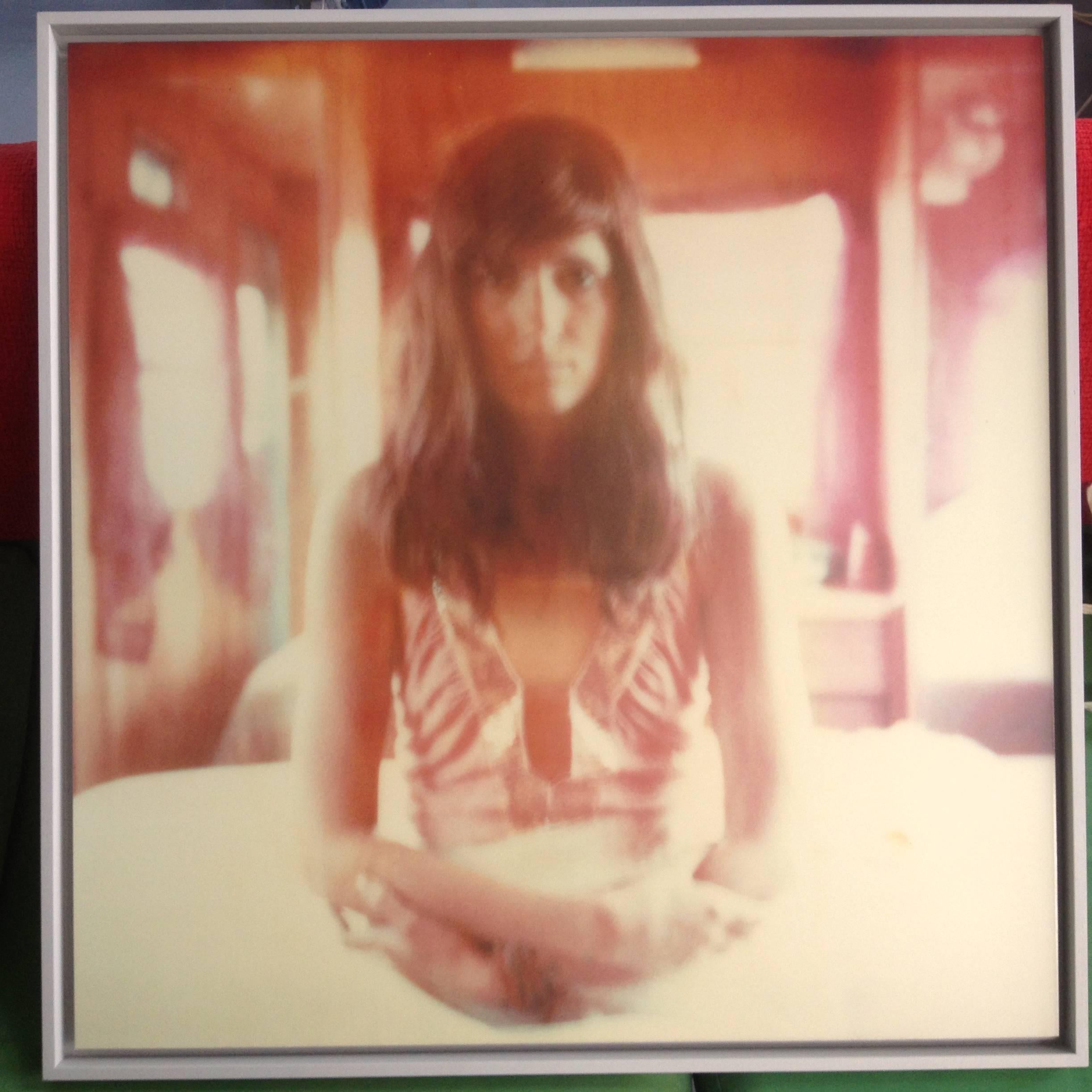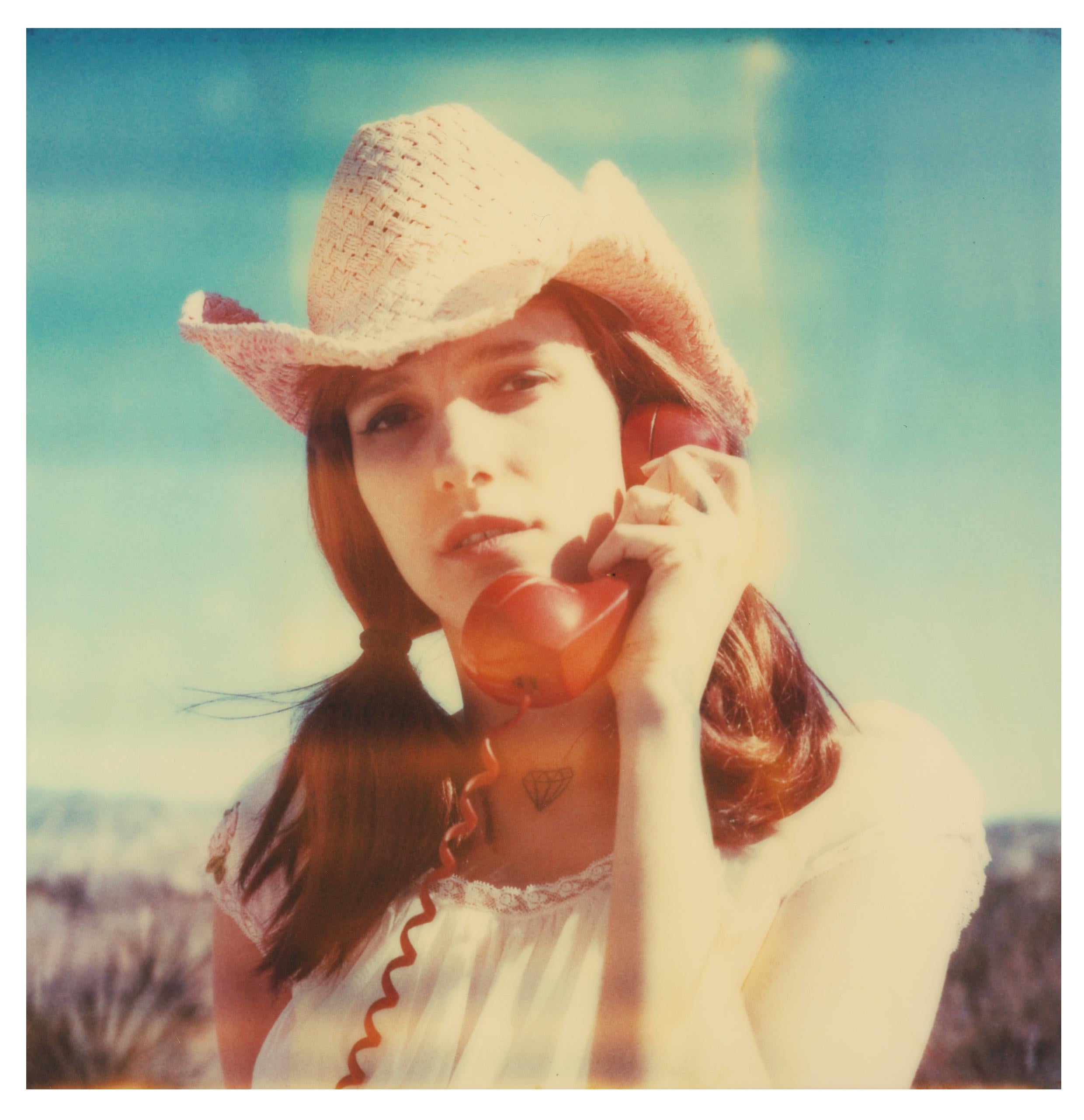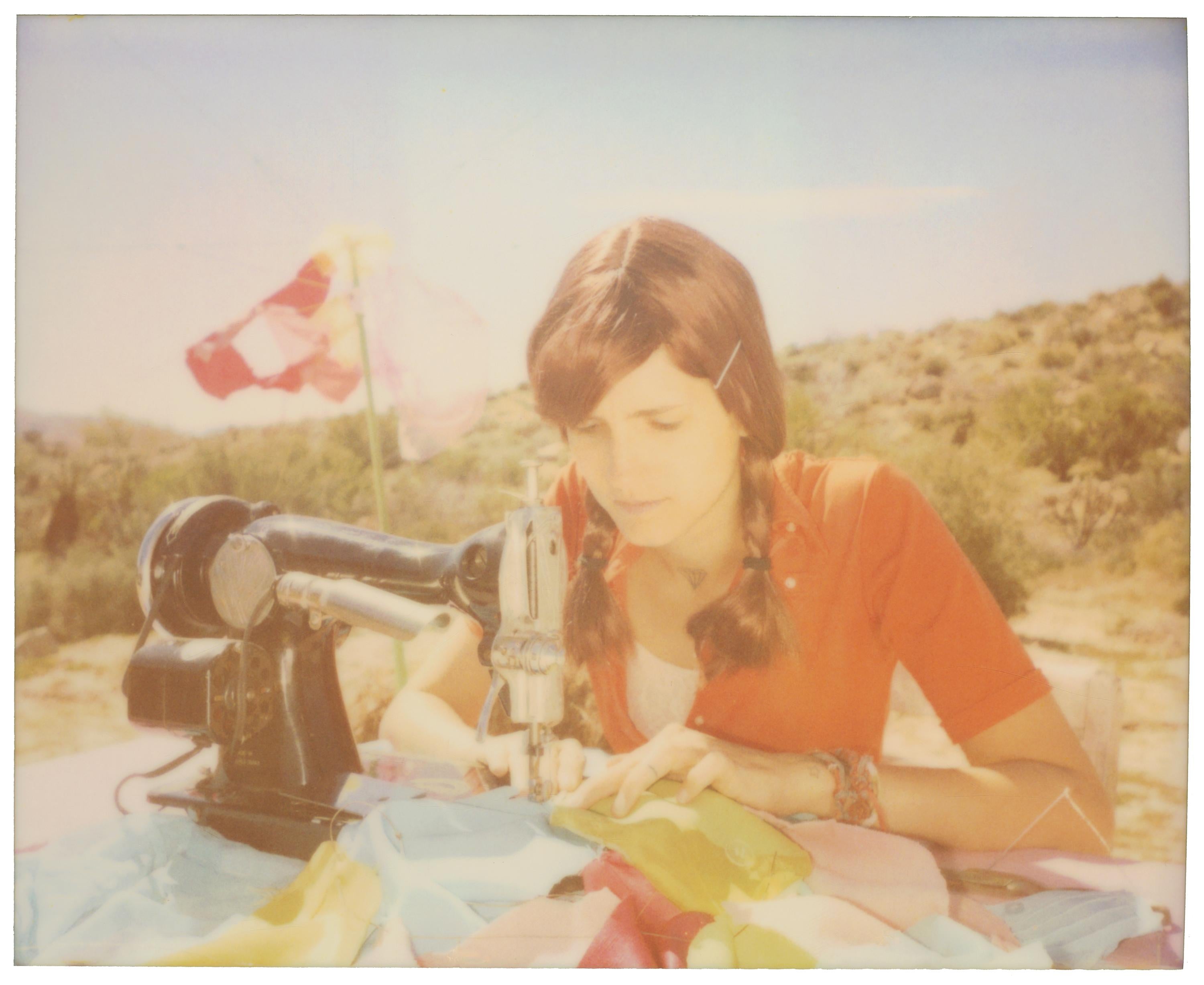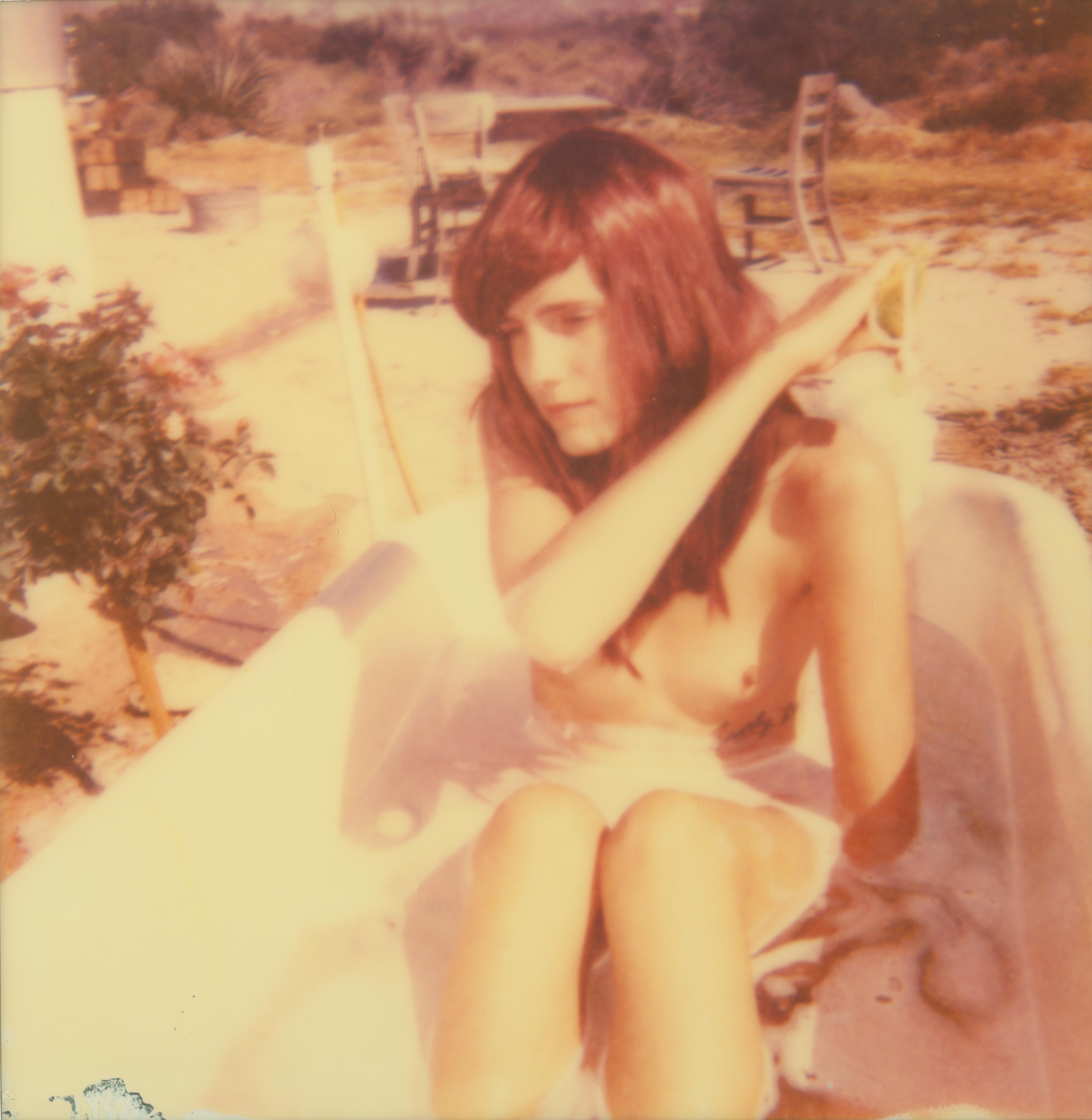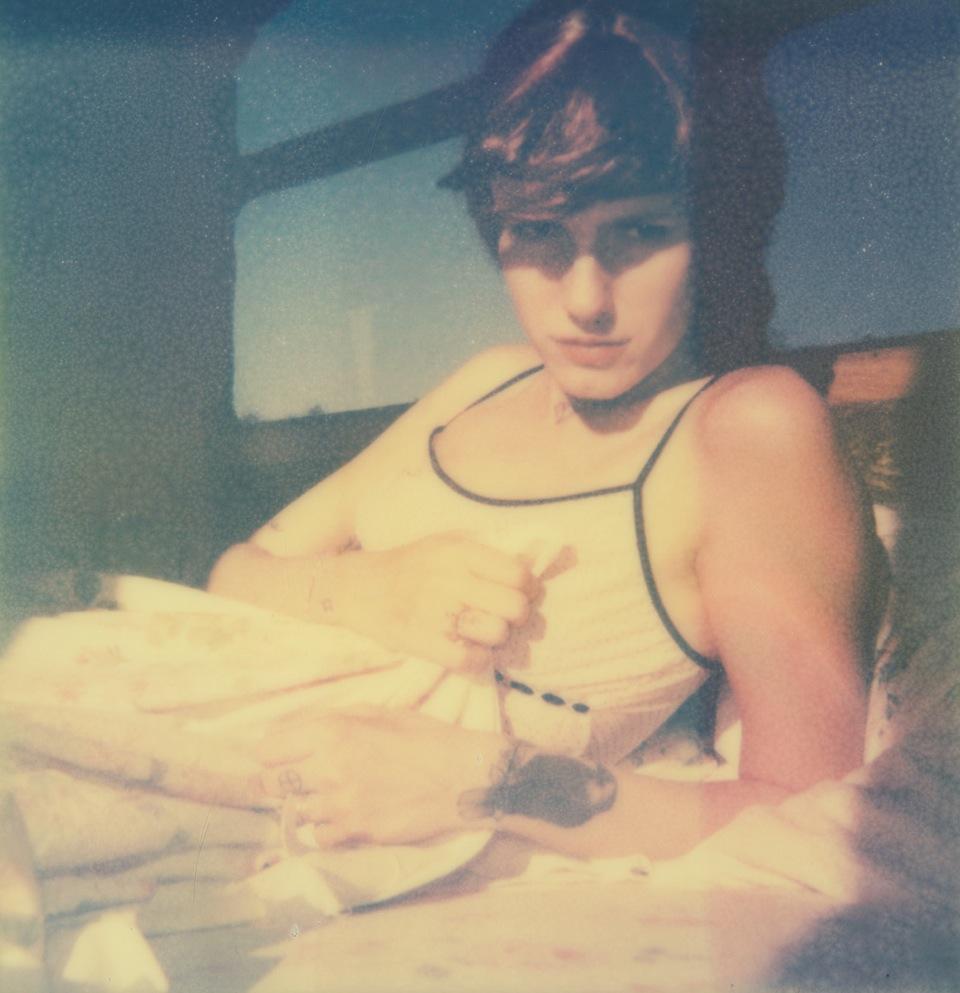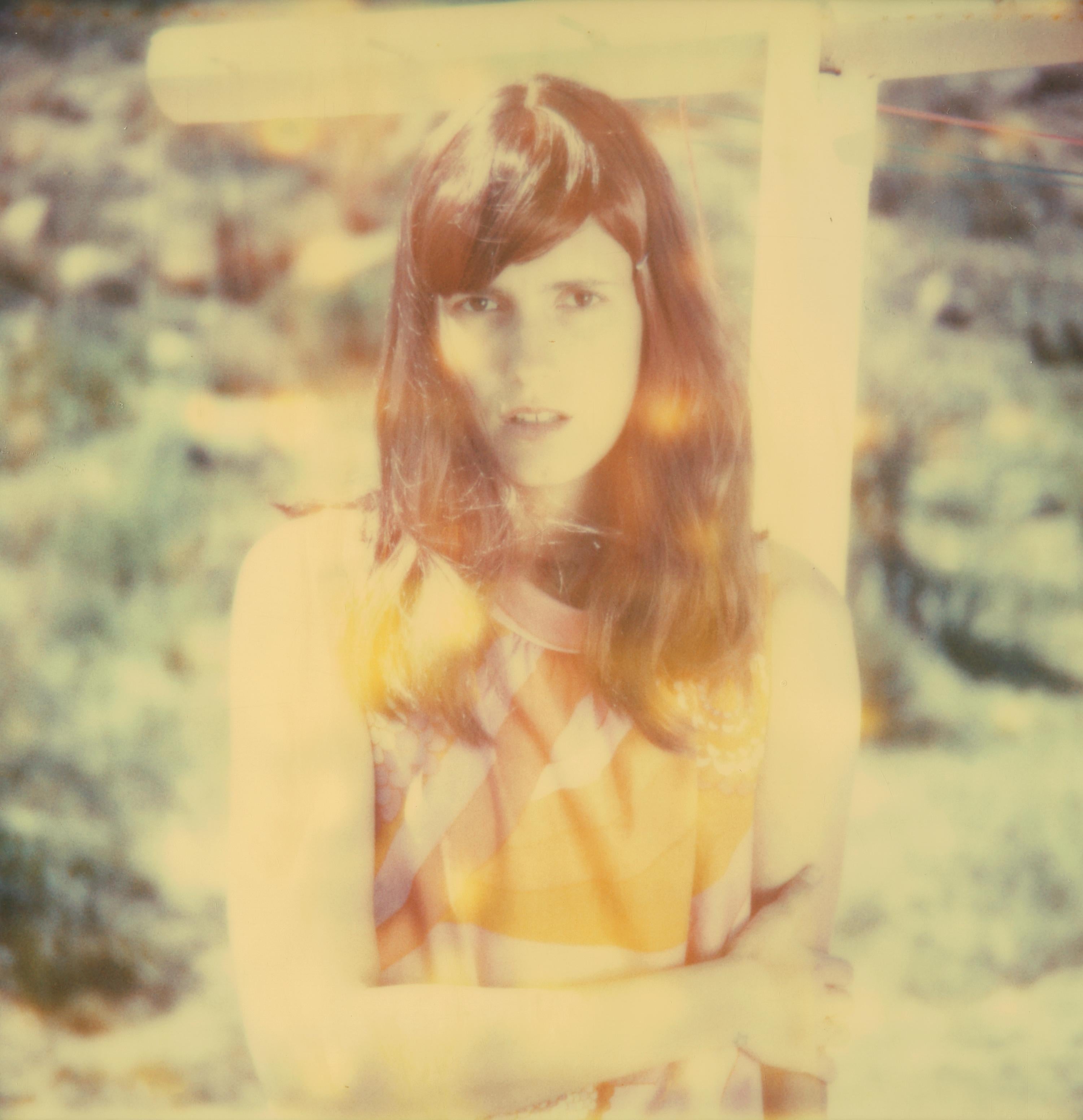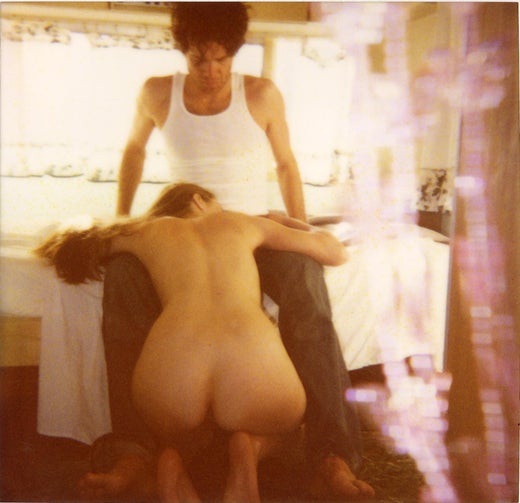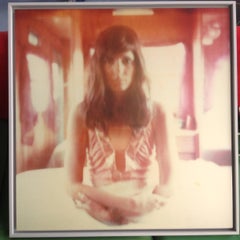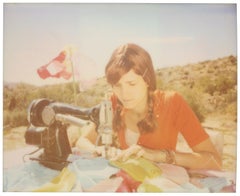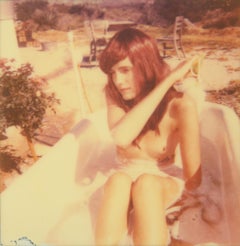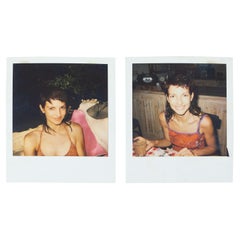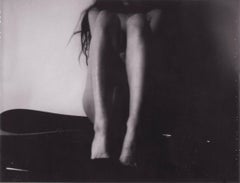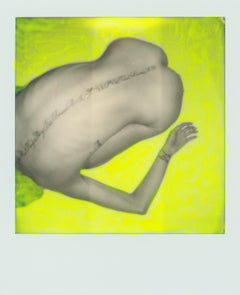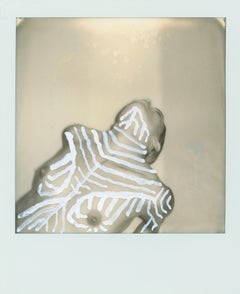Items Similar to A Glass of Whiskey (The Girl behind the White Picket Fence) - Polaroid, Women
Want more images or videos?
Request additional images or videos from the seller
1 of 2
Stefanie SchneiderA Glass of Whiskey (The Girl behind the White Picket Fence) - Polaroid, Women2013
2013
$479.10
£355.04
€400
CA$654.06
A$727.61
CHF 381.42
MX$8,891.24
NOK 4,856.95
SEK 4,572.14
DKK 3,045.56
Shipping
Retrieving quote...The 1stDibs Promise:
Authenticity Guarantee,
Money-Back Guarantee,
24-Hour Cancellation
About the Item
A Glass of Whiskey (The Girl behind the White Picket Fence)
2013, 20x25cm, Edition 7/10,
digital C-Print, based on a Polaroid
Certificate and Signature label
artist Inventory # 16148.14
Offered is a piece from the movie: The Girl behind the White Picket Fence
A tale told with blemished and expired Polaroid film about the hopes and dreams of an newly orphaned girl after loosing her parents who lived in Californian desert in an old travel-trailer .
-filmed with Polaroid film stock and Super-8 footage, overlaid with poetic voice over monoloque - this feature film creates a dynamic kaleidoscope of words and pictures, a dreamy tale that channels Terrence Malick, Gus Van Sant, and pages torn from a lonely girls journal (Palms Springs life magazine / Carolyn Ryder)
Stefanie Schneider lives and works in the Southern California high desert where her scintillating situations take place in the American West. Situated on the verge of an elusive super-reality, her photographic sequences provide the ambience for loosely woven story lines and a cast of phantasmic characters. Schneider works with the chemical mutations of expired polaroid film stock. Chemical explosions of color spreading across the surfaces undermine the photograph's commitment to reality and induce her characters into trance-like dreamscapes. Like flickering sequences of old road movies Schneider's images seem to evaporate before conclusions can be made - their ephemeral reality manifesting in subtle gestures and mysterious motives. Schneider's images refuse to succumb to reality, they keep alive the confusions of dream, desire, fact, and fiction.
“It was Stefanie Schneider, who inspired me to start the company THE IMPOSSIBLE PROJECT after seeing her work, which seems to achieve the possible from the impossible, creating the finest of art out of the most basic of mediums and materials. Indeed, after that one day, I was so impressed with her photography that I realized Polaroid film could not be allowed to disappear. Being at the precise moment in time where the world was about to lose Polaroid, I seized the moment and have put all my efforts and passion into saving Polaroid film. For that, I thank Stefanie Schneider almost exclusively, who played a bigger role than anyone in saving this American symbol of photography.”
–Florian Kaps, March 8th 2010 (“Doc” Dr. Florian Kaps, founder of “The Impossible Project”)
THE GREATER THE EMPTINESS THE GRANDER THE ART – Stefan Gronert
Not “Twenty-six Gasoline Stations” but “29 Palms, CA”! Forty-two years after Ed Ruscha’s legendary book, there is no gasoline station at the beginning of the book that is here at hand. Instead it is the open hearted Radha – with orange hair, pink-colored overalls and a bashful, or rather cunning, gaze that is directed downward – with which this book begins! And with her and with Max – attention: a woman –, one whose appearance is in accordance with the same styling, it comes to an end as well – after Radha has in the meantime colored her fingernails pink, again endowed with the same open heartedness and the same look which now, however, reveals in combination with her altered facial expression an “old-maidish” turning away from the viewer. This may serve as an example for a vivid and understandable transformation which flows into a large-scale representation of a cheerless settlement beneath a shining, blue sky – there a figure, lost straightaway, becomes overwhelmed.
Pictures which in 1998/99 play in the harsh California sunlight or in spaces that are not exactly cozy and comfortable. “Play” is the correct word in this regard, for precisely in view of the pictures of persons, there remains more than just doubt as to whether we are looking at staged scenes or have simply happened upon the high-strung “reality” of a (wannabe) film world. Yet not all the pictures have the same character of a glaring, plastic world. Upon flipping through the pages, we also encounter unpretentious, literally “colorless” scenes in undefined interiors, or unspectacular views resembling a still life and opening out onto a nowhere land. That which connects all participants in these picture-worlds is the observation that they appear to be exhausted, lost, empty or uncertain about their existence. One is almost reminded of the empty gazes and loneliness of the protagonists in the pictures of large cities painted by Manet or Degas in the era of Early Modernism.
With one exception, all the photographs which are reproduced here, which originally measure 60 by 70 cm but which here, in their present size and configuration, make productive use of the possibilities presented by the medium of the book, manifest several elements of B-movies: smoking, naked, made-up and muscular persons who are not inclined to conform entirely to the vision of Hollywood dreams. Beauty and vexation, eroticism and loneliness enter into a mixture which reveals the rift between desire and truth. From a distance, one is reminded of the “Untitled Film Stills” of Cindy Sherman, which in this regard are not nearly as drastic. Yet where as her photos from the seventies are characterized by a cool, objective mode of representation in historicizing black-and-white, the photographs of Stefanie Schneider evince a soft, sometimes seemingly pictorial visual language with a coloration ranging from the pale to the artificial-glaring. As in many other pictures of Stefanie Schneider which often present themselves to us as sequences, these photos refer back as well to the perceptual stereotypes of film. Making use of instant photography, proceeding from which significantly enlarged C-prints come into being, her pictures summon up the impression of a narration without ultimately becoming part of a plot that is readable in a linear fashion. The illusion of the narrative element, however, simply enhances the experience of a renunciation of just this aspect. For the picture titles as well – and also the title of this publication – provide no real help with the imaginary construction of a story.
Nevertheless, names return which include the first name of the artist herself: hence is everything not in fact a game but rather a series of authentic and instantaneous images, or is it after all nothing other than a staging, a game – how real is life? The paucity of plot elements, which contradicts all expectation of a cinematic style, as well as the emptiness and loneliness of the persons, enters into a peculiar, sometimes seemingly surreal association with the magic of the sun-drenched expanses of the dreamlike landscape. Just as the fantasy and imagination of the viewer are stimulated, so to the same great extent does the redemption of these visual figures of love founder on a void whose glaze is created, not least of all, by the peculiar blurriness of the photographic representation. The seemingly amateur character of these pictures, which have in no way been treated with any excessive scrupulousness, leaves us with a stimulating incertitude as to their interpretation, one in which the spheres of reality, fiction or dream are scarcely capable any longer of being differentiated. Thus the gaps and the scenic openness of what is presented ultimately set in motion a self-appraisal.
So what remains after “29 Palms, CA”? Perhaps that hope which deviates from the saying of Ruscha that is quoted in the title: The stronger the photography the better the reality will be!
Translated by George Frederick Takis
Stefanie Schneider received her MFA in Communication Design at the Folkwang Schule Essen, Germany. Her work has been shown at the Museum for Photography, Braunschweig, Museum für Kommunikation, Berlin, the Institut für Neue Medien, Frankfurt, the Nassauischer Kunstverein, Wiesbaden, Kunstverein Bielefeld, Museum für Moderne Kunst Passau, Les Rencontres d'Arles, Foto -Triennale Esslingen.
- Creator:Stefanie Schneider (1968, German)
- Creation Year:2013
- Dimensions:Height: 7.88 in (20 cm)Width: 9.85 in (25 cm)Depth: 0.04 in (1 mm)
- More Editions & Sizes:40x50cm, Edition of 10Price: $719
- Medium:
- Movement & Style:
- Period:
- Condition:
- Gallery Location:Morongo Valley, CA
- Reference Number:1stDibs: LU65237100832
Stefanie Schneider
Stefanie Schneider received her MFA in Communication Design at the Folkwang Schule Essen, Germany. Her work has been shown at the Museum for Photography, Braunschweig, Museum für Kommunikation, Berlin, the Institut für Neue Medien, Frankfurt, the Nassauischer Kunstverein, Wiesbaden, Kunstverein Bielefeld, Museum für Moderne Kunst Passau, Les Rencontres d'Arles, Foto -Triennale Esslingen., Bombay Beach Biennale 2018, 2019.
About the Seller
4.9
Platinum Seller
Premium sellers with a 4.7+ rating and 24-hour response times
Established in 1996
1stDibs seller since 2017
1,032 sales on 1stDibs
Typical response time: 2 hours
- ShippingRetrieving quote...Shipping from: Morongo Valley, CA
- Return Policy
Authenticity Guarantee
In the unlikely event there’s an issue with an item’s authenticity, contact us within 1 year for a full refund. DetailsMoney-Back Guarantee
If your item is not as described, is damaged in transit, or does not arrive, contact us within 7 days for a full refund. Details24-Hour Cancellation
You have a 24-hour grace period in which to reconsider your purchase, with no questions asked.Vetted Professional Sellers
Our world-class sellers must adhere to strict standards for service and quality, maintaining the integrity of our listings.Price-Match Guarantee
If you find that a seller listed the same item for a lower price elsewhere, we’ll match it.Trusted Global Delivery
Our best-in-class carrier network provides specialized shipping options worldwide, including custom delivery.More From This Seller
View AllGravity (The Girl behind the White Picket Fence) - Polaroid, Contemporary, Color
By Stefanie Schneider
Located in Morongo Valley, CA
Gravity (The Girl behind the White Picket Fence) - 2013
80x80cm,
Edition 2/5.
Analog C-Print printed on Fuji Archive Paper, hand-printed by the artist,
based on the Polaroid.
Mou...
Category
2010s Contemporary Color Photography
Materials
Wood, Archival Paper, Photographic Paper, C Print, Color, Polaroid
Her last Call (The Girl behind the White Picket Fence) - Polaroid, 21st Century
By Stefanie Schneider
Located in Morongo Valley, CA
Her last Call II (The Girl behind the White Picket Fence) - 2013
78x77cm,
Edition 3/5,
Analog C-Print, hand-printed by the artist, based on the Polaroid.
Certificate and Signature...
Category
Early 2000s Contemporary Color Photography
Materials
Archival Paper, Photographic Paper, C Print, Color, Polaroid
Rendering Memories (The Girl behind the White Picket Fence) - Polaroid, Portrait
By Stefanie Schneider
Located in Morongo Valley, CA
Rendering Memories II (The Girl Behind the White Picket Fence) - 2013
20x24cm,
Edition of 10, plus 2 Artist Proofs.
Archival C-Print, based on the original Polaroid.
Signature label and certificate.
Artist Inventory #13388.
Not mounted.
Offered is a piece from the movie: The Girl Behind the White Picket Fence. Written and directed by Stefanie Schneider
A tale told with blemished and expired Polaroid film about the hopes and dreams of a newly orphaned girl after losing her parents who lived in the Californian desert in an old travel trailer.
-filmed with Polaroid film stock and Super-8 footage, overlaid with poetic voice-over monologue - this feature film creates a dynamic kaleidoscope of words and pictures, a dreamy tale that channels Terrence Malick, Gus Van Sant, and pages torn from a lonely girl's journal.
(Palms Springs life magazine / Caroline Ryder)
Stefanie Schneider
By Caroline Ryder
Travel up a bumpy dirt road in Morongo Valley, the trail strewn with rocks, and you’ll come upon a gigantic 1950s trailer in pristine condition, ringed by a white picket fence, with cottontail rabbits hopping among neat little rose bushes that bloom in spite of the broiling desert heat.
Inside the trailer are period accents—a vintage radio, vintage fridge, little crocheted doilies, and dusty gilt-framed photographs. It’s a surreal home-sweet-home, an Americana fantasy as imagined by German artist and experimental filmmaker Stefanie Schneider whose work is so inspired by the desert landscape, she made it her home in 2005. “There’s a completely different light here than in Germany, a beautiful light,” says Schneider, whose property in Morongo is dotted with vintage trailers. They surround her midcentury home and serve as sets for her photoshoots or as guest lodgings for her friends from Hollywood and Berlin. “But what I really love about the desert is the desolation,” she continues. “The sense of hope for something that might or might not come. It’s easy to see our dreams projected in the desert.”
Famed for shooting trailer park chic fine art photographs exclusively on vintage Polaroid film, Schneider recently completed her most ambitious project to date—a feature film made entirely of Polaroid stills (4000 images in total), the story set around her magnificent 1950s trailer. The film, called “The Girl Behind The White Picket Fence” tells the story of a broken-hearted girl who lives in the trailer. Her name is Heather, and she is played by model Heather Megan Christie, girlfriend of actor Joaquin Phoenix, and former partner of Red Hot Chili Peppers singer Anthony Kiedis, with whom she has a son. Heather stars opposite Kyle Larson (who plays ‘Hank’), a real-life gypsy fisherman who catches crab in Alaska when he’s not surfing in Southern California. Neither of the two had ever acted before, and never in the history of movie-making has a director shot a film entirely on Polaroid film.
“There was great difficulty shooting a film this way,” says Schneider, who, with her long straight hair, wide innocent eyes, and thick-framed glasses, conjures an art-house Gretel. “If I had used a regular camera I would have had 36 exposures per minute, much faster and easier than using the old Polaroid camera which takes a long time to shoot one frame. Also, sometimes it doesn’t shoot at the exact moment you think it’s going to—but that’s really great because then you miss the perfect moment…and often those are the best shots.” Individually, the Polaroid photographs that comprise 29 PALMS, CA stand alone, but together and in sequence, filmed with super 8 and 16mm film stock and overlaid with poetic voice-over monologues, they create a dynamic kaleidoscope of words and pictures, a dreamy tale that channels Terrence Malick. Gus Van Sant, and pages torn from a lonely girl’s journal.
The idea to shoot a movie in this way came about in 2004 when Schneider was working with leading German director Mark Forster (Monster’s Ball, Finding Neverland, Quantum of Solace) on his film Stay. She had met Forster at director Wim Wender’s birthday party in Hollywood. A few years later, Forster asked Schneider to shoot Polaroids of scenes from Stay as he filmed; he used those photographs for dream and memory sequences in the movie. For the first time, Schneider saw her Polaroids strung together in sequence, moving with rhythm like a flipbook, in the context of a story. When Forster urged her to consider making a feature film using that technique, the seed of 29 PALMS, CA was sown. She mentioned the idea to her good friend German actor Udo Kier, who also gave the idea a big thumbs up, and agreed to play the part of a mysterious shaman in the film.
Thanks to her strong reputation in the art world and her Hollywood connections, getting talented people on board was the easy part (for a while, Charlotte Gainsbourg was pegged to play the starring role, although she pulled out two weeks before shooting commenced because she was pregnant and not fit to travel to the desert.) The hard part was finding the perfect trailer—and bringing it to the desert. “This trailer almost killed us,” says Schneider’s partner Lance Waterman, who lives and works with Schneider in Morongo Valley. After finding it on eBay, the couple drove to Utah to pick it up, the plan being to tow it all the way back to the high desert themselves. Bad idea. “We were driving down a hill with this enormous trailer behind us when we realized that if we wanted to stop, there would be no way to do so without the trailer crushing us,” says Waterman. Adds Schneider: “Lance was even giving me instructions on how to jump out of the truck if we needed to.” Thankfully the road leveled and as soon as they were able to slow down and pull over, they called a professional towing company, which transported the trailer the remaining distance to Morongo Valley.
Filming took place in Spring 2011 and 2012. Schneider recently submitted the film to major film festivals in Europe and the US, and it will be broadcast in 2013 by leading German television channel, Arte. While Schneider may come from a long tradition of photographers-turned-filmmakers—Stanley Kubrick started out as a photographer, as did Ken Russell (Tommy, Women in Love) and Larry Clark, who was a controversial fine art photographer before directing smash hit Kids—she does not see her future in Hollywood, directing blockbusters. Not necessarily. “I don’t think I want to make more films,” she says. “The actors were saying they would love to work with me again, and were asking if I would like to make other movies. But being on movie sets is far too stressful, and at least with this, I was in complete power of what was going on creatively. That said, if this gets a lot of acclaims…we can always think again. One should never say never.”
Film features
original soundtrack with songs by Adam Weiss, Daisy McCrackin, Billy Harvey, Sophie Huber, Zoe Bicat, Max Sharam, Cheyenne Randall...
Category
2010s Contemporary Color Photography
Materials
Archival Paper, Photographic Paper, C Print, Color, Polaroid
The Girl IV (The Girl behind the White Picket Fence) - Contemporary, Polaroid
By Stefanie Schneider
Located in Morongo Valley, CA
The Girl IV (The Girl behind the White Picket Fence) - 2013
38x36cm,
Edition of 10.
Analog C-Print, hand-printed by the artist on Fuji Archive Crystal Paper, matte surface,
based...
Category
2010s Contemporary Color Photography
Materials
Archival Paper, Photographic Paper, C Print, Color, Polaroid
Morning Glory (The Girl behind the White Picket Fence) - Polaroid, 21st Century
By Stefanie Schneider
Located in Morongo Valley, CA
Morning Glory (The Girl behind the White Picket Fence)
2013, 80x80cm, Edition 1/5.
Analog C-Print, hand-printed by the artist.
Certificate and Signature label.
Artist Inventory # 164...
Category
Early 2000s Contemporary Color Photography
Materials
Archival Paper, Photographic Paper, C Print, Color, Polaroid
Traces of Time II (The Girl behind the White Picket Fence) - Polaroid, Portrait
By Stefanie Schneider
Located in Morongo Valley, CA
Traces of Time II (The Girl Behind the White Picket Fence) - 2013
20x20cm,
Edition of 10, plus 2 Artist Proofs.
Archival C-Print, based on the original Polaroid.
Signature label and certificate.
Artist Inventory #13371.
Not mounted.
Offered is a piece from the movie: The Girl Behind the White Picket Fence. Written and directed by Stefanie Schneider
A tale told with blemished and expired Polaroid film about the hopes and dreams of a newly orphaned girl after losing her parents who lived in the Californian desert in an old travel trailer.
-filmed with Polaroid film stock and Super-8 footage, overlaid with poetic voice-over monologue - this feature film creates a dynamic kaleidoscope of words and pictures, a dreamy tale that channels Terrence Malick, Gus Van Sant, and pages torn from a lonely girl's journal.
(Palms Springs life magazine / Caroline Ryder)
Stefanie Schneider
By Caroline Ryder
Travel up a bumpy dirt road in Morongo Valley, the trail strewn with rocks, and you’ll come upon a gigantic 1950s trailer in pristine condition, ringed by a white picket fence, with cottontail rabbits hopping among neat little rose bushes that bloom in spite of the broiling desert heat.
Inside the trailer are period accents—a vintage radio, vintage fridge, little crocheted doilies, and dusty gilt-framed photographs. It’s a surreal home-sweet-home, an Americana fantasy as imagined by German artist and experimental filmmaker Stefanie Schneider whose work is so inspired by the desert landscape, she made it her home in 2005. “There’s a completely different light here than in Germany, a beautiful light,” says Schneider, whose property in Morongo is dotted with vintage trailers. They surround her midcentury home and serve as sets for her photoshoots or as guest lodgings for her friends from Hollywood and Berlin. “But what I really love about the desert is the desolation,” she continues. “The sense of hope for something that might or might not come. It’s easy to see our dreams projected in the desert.”
Famed for shooting trailer park chic fine art photographs exclusively on vintage Polaroid film, Schneider recently completed her most ambitious project to date—a feature film made entirely of Polaroid stills (4000 images in total), the story set around her magnificent 1950s trailer. The film, called “The Girl Behind The White Picket Fence” tells the story of a broken-hearted girl who lives in the trailer. Her name is Heather, and she is played by model Heather Megan Christie, girlfriend of actor Joaquin Phoenix, and former partner of Red Hot Chili Peppers singer Anthony Kiedis, with whom she has a son. Heather stars opposite Kyle Larson (who plays ‘Hank’), a real-life gypsy fisherman who catches crab in Alaska when he’s not surfing in Southern California. Neither of the two had ever acted before, and never in the history of movie-making has a director shot a film entirely on Polaroid film.
“There was great difficulty shooting a film this way,” says Schneider, who, with her long straight hair, wide innocent eyes, and thick-framed glasses, conjures an art-house Gretel. “If I had used a regular camera I would have had 36 exposures per minute, much faster and easier than using the old Polaroid camera which takes a long time to shoot one frame. Also, sometimes it doesn’t shoot at the exact moment you think it’s going to—but that’s really great because then you miss the perfect moment…and often those are the best shots.” Individually, the Polaroid photographs that comprise 29 PALMS, CA stand alone, but together and in sequence, filmed with super 8 and 16mm film stock and overlaid with poetic voice-over monologues, they create a dynamic kaleidoscope of words and pictures, a dreamy tale that channels Terrence Malick. Gus Van Sant, and pages torn from a lonely girl’s journal.
The idea to shoot a movie in this way came about in 2004 when Schneider was working with leading German director Mark Forster (Monster’s Ball, Finding Neverland, Quantum of Solace) on his film Stay. She had met Forster at director Wim Wender’s birthday party in Hollywood. A few years later, Forster asked Schneider to shoot Polaroids of scenes from Stay as he filmed; he used those photographs for dream and memory sequences in the movie. For the first time, Schneider saw her Polaroids strung together in sequence, moving with rhythm like a flipbook, in the context of a story. When Forster urged her to consider making a feature film using that technique, the seed of 29 PALMS, CA was sown. She mentioned the idea to her good friend German actor Udo Kier, who also gave the idea a big thumbs up, and agreed to play the part of a mysterious shaman in the film.
Thanks to her strong reputation in the art world and her Hollywood connections, getting talented people on board was the easy part (for a while, Charlotte Gainsbourg was pegged to play the starring role, although she pulled out two weeks before shooting commenced because she was pregnant and not fit to travel to the desert.) The hard part was finding the perfect trailer—and bringing it to the desert. “This trailer almost killed us,” says Schneider’s partner Lance Waterman, who lives and works with Schneider in Morongo Valley. After finding it on eBay, the couple drove to Utah to pick it up, the plan being to tow it all the way back to the high desert themselves. Bad idea. “We were driving down a hill with this enormous trailer behind us when we realized that if we wanted to stop, there would be no way to do so without the trailer crushing us,” says Waterman. Adds Schneider: “Lance was even giving me instructions on how to jump out of the truck if we needed to.” Thankfully the road leveled and as soon as they were able to slow down and pull over, they called a professional towing company, which transported the trailer the remaining distance to Morongo Valley.
Filming took place in Spring 2011 and 2012. Schneider recently submitted the film to major film festivals in Europe and the US, and it will be broadcast in 2013 by leading German television channel, Arte. While Schneider may come from a long tradition of photographers-turned-filmmakers—Stanley Kubrick started out as a photographer, as did Ken Russell (Tommy, Women in Love) and Larry Clark, who was a controversial fine art photographer before directing smash hit Kids—she does not see her future in Hollywood, directing blockbusters. Not necessarily. “I don’t think I want to make more films,” she says. “The actors were saying they would love to work with me again, and were asking if I would like to make other movies. But being on movie sets is far too stressful, and at least with this, I was in complete power of what was going on creatively. That said, if this gets a lot of acclaims…we can always think again. One should never say never.”
Film features
original soundtrack with songs by Adam Weiss, Daisy McCrackin, Billy Harvey, Sophie Huber, Zoe Bicat, Max Sharam, Cheyenne Randall...
Category
2010s Contemporary Color Photography
Materials
Archival Paper, Photographic Paper, C Print, Color, Polaroid
You May Also Like
Miquel Arnal Set of Polaroid Photographs
By Miquel Arnal
Located in Barcelona, Barcelona
Set of polaroid photographs by Miquel Arnal.
In original condition, with minor wear consistent with age and use, preserving a beautiful patina.
Material:
Photographic paper
...
Category
1990s Spanish Post-Modern Photography
Materials
Paper
$464 Sale Price / set
50% Off
Chelsea Hotel #3 – Emma Summerton, Polaroid, Interior, Woman, Nude, Polaroid
By Emma Summerton
Located in Zurich, CH
Emma SUMMERTON (*1970, Australia)
Chelsea Hotel #3, 2003
Archival pigment print on Hahnemühle Paper
100 x 120 cm (39 3/8 x 47 1/4 in.)
Edition of 5, plus 2 AP; Ed. no. 1/5
Print only...
Category
Early 2000s Contemporary Color Photography
Materials
Archival Pigment
Price Upon Request
Free Shipping
"Pola Girls 7" Nude Polaroid Photography - Unique piece by Larsen Sotelo
By Larsen Sotelo
Located in Culver City, CA
"Pola Girls 7" Nude Polaroid Photography - Unique piece by Larsen Sotelo
4.2" x 3.5" inch - including white Polaroid frame
3.1" x 3,1" inch - image area
C...
Category
21st Century and Contemporary Contemporary Nude Photography
Materials
Polaroid
"Pola Girls 15" Nude Polaroid Photography - Unique piece by Larsen Sotelo
By Larsen Sotelo
Located in Culver City, CA
"Pola Girls 15" Nude Polaroid Photography - Unique piece by Larsen Sotelo
4.2" x 3.5" inch - including white Polaroid frame
3.1" x 3,1" inch - image area
...
Category
21st Century and Contemporary Contemporary Nude Photography
Materials
Polaroid
Miquel Arnal Set of Polaroid Photographs
By Miquel Arnal
Located in Barcelona, Barcelona
Set of Polaroid photographs by Miquel Arnal.
In original condition, with minor wear consistent with age and use, preserving a beautiful patina.
Material:
Photographic paper
...
Category
1990s Spanish Post-Modern Photography
Materials
Paper
$449 Sale Price / set
50% Off
"Pola Girls 12" Nude Polaroid Photography - Unique piece by Larsen Sotelo
By Larsen Sotelo
Located in Culver City, CA
"Pola Girls 12" Nude Polaroid Photography - Unique piece by Larsen Sotelo
4.2" x 3.5" inch - including white Polaroid frame
3.1" x 3,1" inch - image area
...
Category
21st Century and Contemporary Contemporary Nude Photography
Materials
Polaroid
More Ways To Browse
Woven Glass Art
Large Art Glass Sphere
Naked Women Pictures
Toy Story
Vintage Cartoon Posters
Alexander Calder Mobile
Biology Prints
Framed Vintage Floral Prints
Pablo Picasso Pencil Drawing
Richard Hollander
Swiss Army
Expensive Sculptures
Kinetic Light Sculpture
Moderna Museet
Nuns In Art
Obey Print
Ottoman Painting
Peter Max Signed Lithograph
